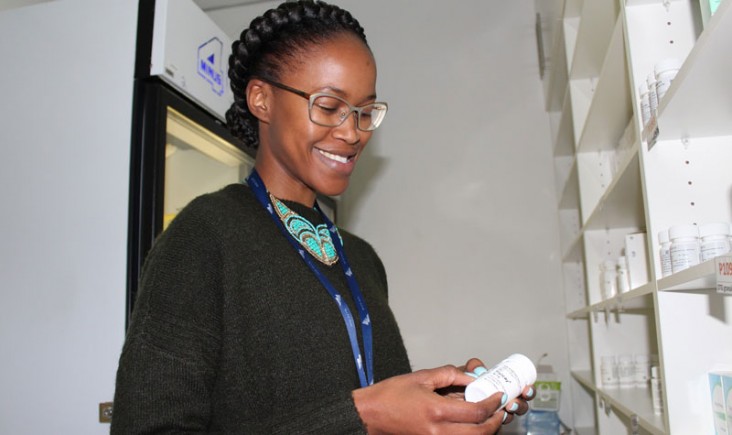- What We Do
- Agriculture and Food Security
- Democracy, Human Rights and Governance
- Economic Growth and Trade
- Education
- Ending Extreme Poverty
- Environment and Global Climate Change
- Gender Equality and Women's Empowerment
- Global Health
- Water and Sanitation
- Working in Crises and Conflict
- U.S. Global Development Lab


Talia Dweck, Masters in Global Human Development
Talia Dweck is a former Research Intern in USAID's Office of HIV/AIDS. During her time at USAID, Talia supported OPTIMIZE, a global partnership working to accelerate access to simpler, safer and more affordable HIV treatment. She currently works as an Information and Communications Technology Specialist at DAI.
Recent Blog Posts
- The Road to IAS 2017: Insights from International AIDS Society President Linda-Gail Bekker
Linda-Gail Bekker and Benny Kottiri - July 19, 2017 - 'But what if it falls out?' Using Human-Centered Design to Answer Questions about the Dapivirine Ring
Elizabeth Russell and Emily Harris - July 11, 2017
On June 28, 2017, the Government of Kenya announced the introduction of Dolutegravir (DTG) as a first-line antiretroviral (ARV) drug for people living with HIV into the national regimen. This is a significant milestone in the transition to regimens containing DTG – a less toxic, less resistant and more affordable drug – as Kenya is the first African country to introduce the generic version for routine use. Kenya's efforts are part of a multi-country initiative through the Unitaid-funded Clinton Health Access Initiative (CHAI) Optimal ARV drug project and follow 2016 announcements from Botswana and Brazil announcing large-scale introduction of DTG for first-line treatment (for details, see the recently released WHO Technical Update on Transition to New Antiretroviral Drugs in HIV Programmes: Clinical and Programmatic Considerations [PDF, 1.7MB]). These efforts demonstrate the progress made toward antiretroviral therapy (ART) optimization – the harmonization of global efforts to accelerate access to simpler, safer and more affordable HIV treatment. As other countries follow these early adopter countries' lead, it is important to understand the potential that this change and other advances in the ART optimization effort can have in transforming the lives of people living with HIV.
Over the past 3 years, the U.S. President's Emergency Plan for AIDS Relief (PEPFAR)-supported and U.S. Agency for International Development (USAID)-managed OPTIMIZE consortium – in conjunction with a diverse group of international partners comprised of the World Health Organization (WHO), Global Fund to Fight AIDS, Tuberculosis and Malaria, Unitaid and its partners, including CHAI – has made significant progress toward increasing access to optimized HIV treatment through the following approaches:
- Building scientific consensus to identify and address the clinical trial data gaps required to obtain global and country-specific regulatory approvals for optimized ART.
- Harnessing innovative technologies and processes to dramatically reduce drug dosages and cost, while maintaining optimized ART's effectiveness.
- Working globally and locally to support sustainable, competitive ART markets and accelerate the introduction of optimized ART at the country level.
During the 2017 International AIDS Society (IAS) conference in Paris this week, HIV and infectious disease scientists from all over the world will come together to map out strategies to achieve HIV/AIDS epidemic control. With a range of ART optimization efforts on the agenda, IAS is an important opportunity for leading experts to discuss critical next steps to accelerating introduction of DTG-based combinations and other optimized ARVs.
To facilitate these discussions, CHAI is hosting a satellite session entitled, "Accelerating Access to Dolutegravir and Other Optimal ARVs," on Wednesday, July 26, 7:00am–8:30 am CET. The session will be chaired by Dr. Yogan Pillay from the National Department of Health in South Africa and will feature experts from the Ministries of Health of Botswana, Kenya and South Africa, as well as the WHO, African Community Advisory Board, Unitaid, ICAP and CHAI. It will showcase practical considerations and best practices for accelerating the introduction of optimized HIV treatment in select African countries. These lessons will help inform future efforts at both the global and country levels as we move into the next phase of ART optimization.\
To get ready for these important discussions in Paris, and to prepare for the country-specific discussions anticipated to follow, a number of resources exist that can help IAS attendees learn more about the progress and the challenges ahead in accelerating the introduction of optimized ARVs.
- Accelerating Access to Simpler, Safer, and More Affordable HIV Treatment through ART Optimization [PDF, 2.4MB]: A report on the importance of ART optimization, the new drugs that will help achieve optimization and their benefits, including cost savings, and recommendations for how the international community can decrease the time it takes to make these drugs available and safely adopted in low- and middle-income countries (LMICs).
- The ADVANCE Study: A Groundbreaking Trial to Evaluate a Candidate Universal Antiretroviral Regimen: A review of the ADVANCE study, a large, randomized control study testing a combination of two candidate antiretrovirals (DTG and Tenofovir alafenamide) against the current first-line medications. The review describes how a unique consortium of stakeholders came together to rapidly create high-caliber evidence for the new regimens. It discusses the study design, including how it addresses complex issues such as tuberculosis and pregnancy.
- South Africa Needs Assessment for Optimized Antiretroviral Drugs and Regimens [PDF, 4.1MB]: A needs assessment that analyzes the capacity and readiness of South Africa in its transition to optimized ARVs. The document assesses four functional domains: 1) Policy, Advocacy and Finance; 2) Planning Processes and Tools; 3) Service Delivery Capacity; and 4) Transition Monitoring and Visibility. It concludes that while there are areas that require additional focus and investment, South Africa has strong human and institutional capacity in several domains that are critical to the ART optimization process.
There is enormous potential for new ARV regimens to transform treatment for people living with HIV in LMICs. As early adopter countries such as Kenya work to expand access to these improved life-saving drugs, USAID and its OPTIMIZE consortium partners will continue to learn from their experiences in an effort to ensure that the goal of accelerated access to optimized ARVs is realized in the near future.







Add new comment